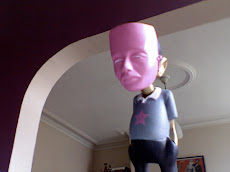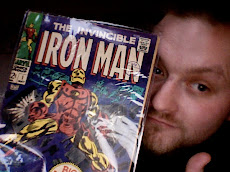



ARRGH I DIDN'T WRITE THIS REVIEW,BUT I'VE LOST WHO DID, AND I DONT WANT TO REMOVE IT BECAUSE ITS GOOD
Cult Fiction explores the reciprocal relationship between comics and art. The exhibition foregrounds links between the two genres in works where current social and political issues are aired in frank visual narratives.
The visual language of comics and graphic novels has influenced many contemporary artists, who have employed its conventions of pictorial narrative and unique fusion of word and image. Fine artists Adam Dant, Kerry James Marshall and Olivia Plender have published their own comics attracted by the mediums democratic format and its ability to reach and influence a wider audience than a gallery context would permit. Glen Baxter, Raymond Pettibon and David Shrigley use a combination of word and image in forms that are reminiscent of popular cartoons. The recurring themes and characters typical of comics iconography can be seen in Laylah Ali’s cast of bowling-ball headed characters, or the ragged furry felines that appear in Jon Pylypchuk’s sculptural tableaux. Liz Craft, Kerstin Kartscher and Paul McDevitt employ graphic elements from comic book imagery to create works that suggest narrative without using words.
The comics artists and graphic novelists are mainly from the generation of independent author-draughtsmen, whose subject matter tends to be offbeat and transgressive, and sometimes controversial. ‘Real life issues’, often approached in biographical or autobiographical styles, supplant moralistic tales of good and evil. Julie Doucet’s diaristic portrayals of her character in vulnerable and compromising situations exemplify the genre’s ability to communicate difficult emotional information, as do Debbie Drechsler’s candid autobiographic explorations of childhood abuse. The true realities of life within a war zone are sensitively charted in Joe Sacco’s award-winning Palestine, while everyday characters such as R Crumb’s and Harvey Pekar’s file clerk in American Splendor and Daniel Clowes’ misfit David Boring become unlikely heroes of everyday tales. Classic Literature gets a make-over for the twenty-first century in Posy Simmonds’ Gemma Bovery which is based on Flaubert’s adulterous heroine Madame Bovary, and Melinda Gebbie’s and Alan Moore’s epic Lost Girls (shortly to be published in the UK) charts the sexual awakening of three characters from children’s literature – Alice from Alice in Wonderland, Dorothy from the Wizard of Oz and Wendy from Peter Pan – as told by their older selves.
Artists: Laylah Ali, Glen Baxter, Stéphane Blanquet, Daniel Clowes, Liz Craft, R. Crumb, Adam Dant, Julie Doucet, Debbie Drechsler, Marcel Dzama, Melinda Gebbie in collaboration with Alan Moore, Mark Kalesniko, Kerstin Kartscher, Killoffer, Kerry James Marshall, Chad McCail, Paul McDevitt, Travis Millard, Kim L Pace, Raymond Pettibon, Olivia Plender, Jon Pylypchuk, James Pyman, Joe Sacco, David Shrigley in collaboration with Yoshitomo Nara and Chris Shepherd, Posy Simmonds, Richard Slee, Carol Swain
Cult Fiction was originated by artist and curator, Kim L. Pace, and is co-curated with Hayward curator Emma Mahony. A fully illustrated catalogue, designed by Jacob Covey, Art Director of Fantagraphics Books, features essays by Paul Gravett and Emma Mahony and a picture-essay by Kim L. Pace. All of the participating artists in Cult Fiction have contributed a drawn self-portrait together with their handwritten answers to questions posed by the curators. The book is distributed by Cornerhouse Publications.
















